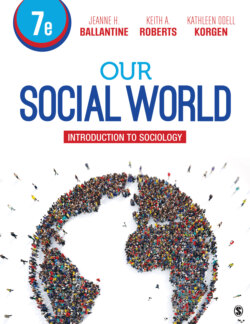Читать книгу Our Social World - Kathleen Odell Korgen - Страница 179
На сайте Литреса книга снята с продажи.
Descriptions of Images and Figures
ОглавлениеBack to Figure
An illustration shows two circles named, self and others on opposite ends. Numbered arrows goes two and fro between the circles and this explains the looking-glass-self process of self-development.
1 Arrow from self to others: “We imagine how we want to appear to others.”
2 Arrow from others to self: “Others make judgments and respond.”
3 Arrow from self to others: “We experience feelings and react based on our interpretations.”
Back to Figure
A line graph illustrates the different social media that’s in use by adults in the U.S. The survey question is, “Percentage of U.S. adults who say they use the following social media sites online or on their cellphone”. Y-axis shows the percentage from 0 to 80 in increments of 20 percent and X-axis shows the years from 2012 till 2018. The different social media and their percentage of use is as follows.
WhatsApp: There is no line for this media, but only a mark at 22 percent in 2018.
Twitter: This line starts approximately at 14 percent in 2012 and climbs slowly and steadily. In 2018, the percentage of use is at 24 percent.
LinkedIn: This line fluctuates a little over the years, but in general slopes upwards. The line starts at approximately 17 percent in 2012 and ends at 25 percent in 2018.
Snapchat: There is no line for this media, but only a mark at 27 percent in 2018.
Pinterest: The line starts at approximately 11 percent in 2012 and generally slopes upward with little fluctuation. It ends at 29 percent in 2018.
Instagram: This line climbs steadily upwards over the years. It starts at approximately 10 percent in 2012, and ends at 35 percent in 2018.
Facebook: This line starts at approximately 56 percent in 2012, and climbs to near 68 percent in the mid of 2015. From here, the line is flat straight till 2018, where it also ends at 68 percent.
YouTube: There is no line for this media, save a point in 2018, at 73 percent.
Back to Figure
A bar graph shows the results from the survey, “Percentage of U.S. teens who say they use the internet, either on a computer or a cellphone . . .” The results are as follows.
In 2018:
Almost constantly: 45 percent.
Several times a day: 44 percent.
Less often: 11 percent a day.
Between 2014 and 2015:
Almost constantly: 24 percent.
Several times a day: 56 percent.
Less often: 20 percent a day.
Back to Figure
A world map shows internet users per 100 people in darker shades as per increase in the number of internet users. Internet user numbers, by countries are as represented below.
less than 12.25: Afghanistan, Turkey, Syria, Madagascar, Burma, Cambodia, Papa New Guinea, and a few African countries like Mali, Niger, Chad, Democratic Republic of Congo, and so on.
between 12.26 and 31.70: India, Nepal, Pakistan, Mongolia, and many African countries like Algeria, Libya, Egypt, Zimbabwe, and so on.
between 31.71 and 51.04: China, Ukraine, Iran, Turkey. In South America, Ecuador, Peru, Bolivia, Paraguay, and so on. Mexico in North America, and a few African countries like South America, Egypt, Kenya, and so on.
between 51.05 and 65.40: Most South American countries are between this number. Kazakhstan, Saudi Arabia, and a few European countries like Italy, Bulgaria, Belarus are also in this range.
more than 65.41: Many countries in the world have internet users between these numbers. U.S., Canada, and Greenland. Most European countries like Spain, Sweden, Norway, Denmark, U.K., and so on. Russia, U.A.E., Oman, Malaysia, and Australia also have internet users above this range.
